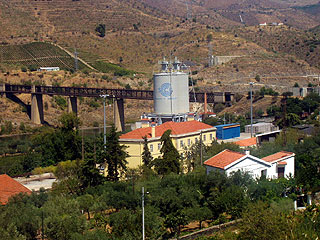
The Sabor line(Linha do Sabor) was a 1,000 mmmetre gauge railway in north-east Portugal. It ran for nearly 106 km between Pocinho and Duas Igrejas, near Miranda do Douro. It closed in 1988.

Barreiro is a railway station on the Alentejo Line that serves as a connection between rail services on the South Bank of the Tagus and Soflusa's river transport to Lisbon, Portugal. The first Barreiro station began operating on June 15, 1857, although it was not inaugurated until February 1, 1861. Since it was too far from the river pier, a new station was built and inaugurated in 1884. This station included an important workshop hub, which underwent extension work during the 1900s, but the facilities were becoming insufficient for the demand by the following decade. However, political and social instability, which was reflected in the administration of the railroads, dragged out the process. It was not until the 1930s that the new workshops were completed. Meanwhile, in 1923 the Ramal do Seixal branch line went into service, and in 1935 the railway between Barreiro and Lavradio was duplicated. The Barreiro station was remodeled and expanded in 1943, and in the 1950s the workshops began to house diesel locomotives from other lines that had been electrified. On December 14, 2008, a new Barreiro station was inaugurated, and the old one was closed.
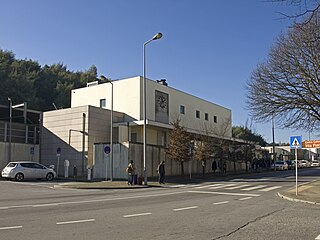
Guimarães railway station is the terminus of the Linha de Guimarães, a 1,668 mm gauge railway line that runs from Porto to the municipality of Guimarães, in the Braga District of Portugal. It was officially opened on 14 April 1884.

The Régua railway station previously known as Regoa railway station, is a station on the Douro Line, which serves the town of Peso da Régua, in the District of Vila Real, in Portugal. It opened in 1879, and served as a junction point with the Corgo Line, which operated between 1906 and 2009.

The Vila Real de Santo António railway station is a station on the Algarve line that serves the city of Vila Real de Santo António, in the district of Faro, Portugal. The original station went into service on 14 April 1906, and the new building was inaugurated on 4 September 1945.

The Zimbro halt was a station on the Sabor line, located in the municipality of Torre de Moncorvo in Portugal.

The Duas Igrejas - Miranda railway station was the terminus of the Sabor line, which served the town of Miranda do Douro, in the Bragança District of Portugal.
The Sanhoane halt, originally called Sanhoane stop, was a station on the Sabor line that served the town of Sanhoane, in the municipality of Mogadouro, Portugal.

The Larinho halt was a station on the Sabor line that served the town of Larinho, in the municipality of Torre de Moncorvo, Portugal.
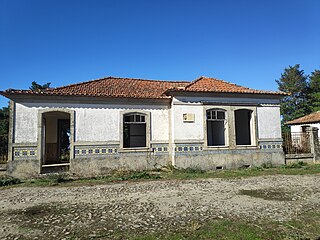
The Urrós halt was a station on the Sabor line that served the town of Urrós, in the municipality of Mogadouro, Portugal.

Pocinho railway station is located on the Iberian gauge Douro line, which serves the town of Pocinho, in the municipality of Vila Nova de Foz Coa, in northern Portugal. It also served as a junction with the Sabor line from its opening in 1911 until its closure in 1988. Since 1988 the station has been the terminus of the Douro Line, following the closure of the section that extended to Barca d'Alva and the Spanish border. There have been calls for this section to be reopened.
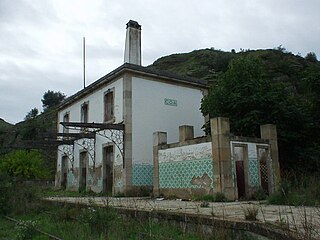
The Coa halt, is a closed interface of the Douro line, which used to serve the town of Vila Nova de Foz Côa, in the Guarda District, in Portugal. The halt started operating on 5 May 1887, and was closed in 2 October 1988.

The Souto da Velha halt was an interface of the Sabor line, which served the town of Souto da Velha, in the municipality of Torre de Moncorvo, in Portugal.
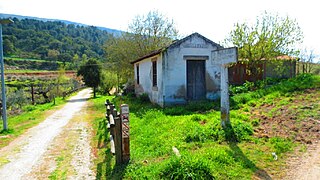
The Quinta de Água halt was a station on the Sabor line, which served the area of Quinta da Água, in the municipality of Torre de Moncorvo, in Portugal.

The Quinta Nova halt was a station on the Sabor line, located in the municipality of Torre de Moncorvo in Portugal.
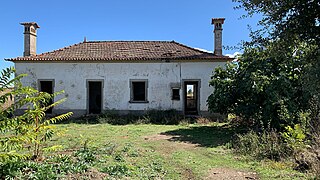
The Fonte de Aldeia halt, originally called Fonte de Aldeia stop, was a station on the Sabor line that served the town of Fonte de Aldeia, in the municipality of Miranda do Douro, Portugal.

The Felgar halt once stood as a crucial stop of the Sabor Line, since it connected and served the town of Felgar and surrounding areas with the rest of the country via train.

The Sendim railway station once operated as a stop along the Sabor line, serving the town of Sendim in the Bragança District of Portugal.

The Variz railway station was a station of the Sabor line, located in the town of Variz, in the parish of Penas Roias, in the municipality of Mogadouro, Portugal.

The Mogadouro railway station, part of the now closed Sabor Line, was a rail interface that served the town of Mogadouro, Bragança District, Portugal.





















